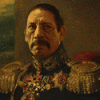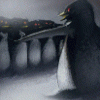I?m basing these impressions of
D&D 4th Edition on reading the books rather than playing the game, which isn?t really the best way to do it. Unfortunately I haven?t yet had a chance to do more than read it, as my
PnP group wants to complete our current campaigns and we?re also interested in trying some of the new RPGs that have been coming out. We?re playing Star Wars Sage Edition at the moment, and want to try Mongoose Publishing?s versions of Traveller and Runequest. So this is a ?how it looks? rather than ?how it plays? impression.
The Player?s Hand Book (PHB) is the core of the system, and where the game has changed most from 3rd edition. It still retains the core D20 system, and it still retains classical abstractions that are such a part of
D&D such as Classes, Levels, Hit Points, etc. However after that it differs quite significantly from previous versions.
One of the most significant ways things have changed is in characters ?powers?. Previously characters had various abilities that came as part of their class and rarely differed from character to character. Now there are often several choices. Where before a paladin had Smite Evil a certain number of times each day, in 4E a paladin can select from Smites that have varied effects which can even heal or protect their allies as well as damage enemies. All characters gain these at the same rate of progression. This affects most severely previous editions spell-casters such as Wizards or Clerics, who have significantly fewer options than they used to, but also classes such as Fighters and Rogues who have many more. These powers come as At-Will (which you can do when you want), Encounter (which you can do once per encounter and need a five-minute rest to regain) and Daily (which need an extended rest of about 8 hours to regain). A majority of these powers are combat related, but a significant number are more likely to be used in social situations and apply bonuses to various rolls.
Another major change is that in 4E any attack actually has to make an attack roll to succeed, even spells. Where previously a Fireball spell would be cast and it?s targets would make a Reflex saving throw for ½ damage, now the person casting the Fireball targets the Reflex Defence of anyone in the area and only does full damage if they hit and ½ on a miss. This works well in SWSE, where the same system operates. Defences increase at the same rate as attacks, with +1 for every 2 character levels.
Damage is another area that has seen significant changes. At low levels characters have a lot more than they would have in previous editions, with a 1st level fighter I created as a test having 31 hit points. They increase at a slower rate - projected to 20th level he had somewhere around 150hp, which isn?t a huge total. Hit points quite explicitly are not just actual physical effects, but also reflect skill, luck, and resolve. As such, sometimes morale effects increase them, and damage doesn?t reflect solely physical wounds. This is something that was stated back in 1st edition days, and then seems to have been ignored till now. A lot of the abilities of the Warlord class affect hit points in a way that implies morale effects rather than healing. The Healing Surge mechanism is an interesting one, since it acts as a limit to the amount of healing a character can receive in the course of an adventuring day. I think the SWSE Condition Track mechanic works well, but I?m not sure that this looks as good.
Where I think the system will work well is at low levels of play, where characters will have a greater variety of abilities compared to previous editions. In particular, in previous editions a Wizard out of spells or a cleric out of healing was usually a sign to stop and rest. Now there is less need to stop, since the Daily powers are a less significant part of a character?s abilities when their Encounter powers are available. At higher levels, previously spell-casters had a lot more options than they do now, though Rituals may change that. There will be a lot less of the ?Rocket Tag? style of play that often seemed to dominate high level play with spell-casters.
The thing I really dislike about the book is the Index (poor at 1 page) and the total lack of a glossary. Some terms are only defined in one place, and that isn?t always the place I?d expect to find them. The section which tells you how to make an attack roll or skill check falls directly between the section on creating character backgrounds and the section on gaining levels in Chapter 1, although it?s also explained in more relevant places.
Moving on to the Dungeon Masters Guide (DMG), it?s an excellent book. It really does a good job of talking about how to create adventures, it gives better information on world-building than previous DMGs, and I would recommend unreservedly as a starting point for people interested in making interesting adventures and campaigns.
The Monster Manual is a book that if you accept the basic philosophy of the edition will suit most DMs and presumably players. Some of the monsters that were left out are a surprise, as are some of those that made it in. A few old favourites have made a comeback, though I?m not holding out much hope for the flumph yet.
As for the physical presentation of the books, they seem fine to me. The layout is crisp and there are sufficient examples to make play clear. Some people have reported problems with the text smudging easily. It hasn?t happened with my books, but there have been a lot of complaints on some web-sites. The art is a bit hit and miss, which I find usual with most RPG books. And I should note that the Wizards web site is expected to provide a lot of support in the future, though for a cost that doesn?t seem to be entirely settled. They already have some interesting articles and adventures available for free, and the Rules Compendium section was up for a time in an apparent trial.
Now I'll address the two big controversies about 4th Edition. Firstly, there's the claim that there are no rules for anything but combat or at least that there's a heavy emphasis on combat in the system. This is to a large degree true. A lot of characters don't have anything special they can do outside a combat situation, although that's not true for all. There aren't rules for some things that did have rules in 3.x, such as Crafting and Profession skills. This isn't necessarily a bad thing. Earlier editions lacked such rules yet they didn't lack in role-playing, so I can see no reason why 4th Edition should be worse at this. I'm not even convinced that you need to keep track of where characters and enemies are more precisely than in older editions, as I always found it useful even in 1st edition especially where magic was concerned.
Secondly, there's a claim that too many of the core races and classes have been changed. Gnomes and Half-orcs have been removed, replaced by Tieflings and Dragonborn. Druids, Sorcerers, Barbarians and Bards are missing, with Warlocks and the Warlord class in. None of this actually bothers me, as it's not unusual for things to change from edition to edition. If I had a particular character who couldn't be converted that might make me annoyed, but I don't and I'm not convinced that it's impossible to create a reasonable approximation of most characters anyway. I'm even less concerned with the claim that by chainging the "fluff" the game is no longer
D&D. That ignores the fact that people have been changing it from the very beginning in homebrew games and the large number of campaign settings that remove, ignore or change aspects that don't fit in.
So, am I pro- or anti-? I'm on the fence still. Some things don't read as if I'll like them, yet I've had that experience before and still found that they play well in practice. Other things look like fun, but again may not turn out as I want. I'm still happy I bought the rules, even if I don't end up playing them much, simply because I am a rules junkie and there's some interesting concepts in the rules. But until I've played at least a short campaign I think I'll keep my opinions set on neutral.
















